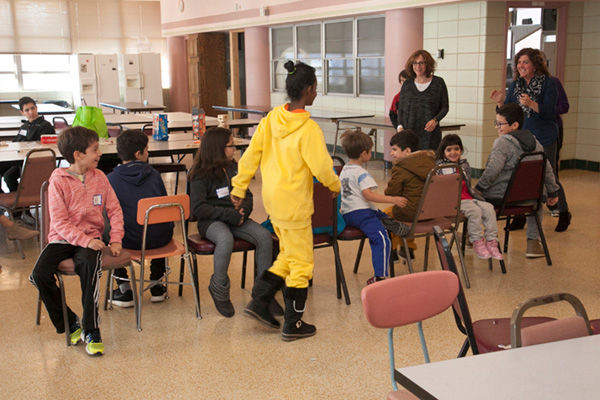Shaare Emeth volunteers help immigrants adjust to life in St. Louis
Published January 26, 2017
For many Americans, the end-of-year holidays and the new year can be a restful time, but for refugees new to our nation, the challenges of learning a new language and nailing down essentials like food and clothing don’t take a holiday.
Now, thanks to a volunteer partnership between the International Institute of St. Louis and Congregation Shaare Emeth, assistance is not far away.
“We’re trying to help [refugees] assimilate to the St. Louis culture and make them feel more comfortable,” said Sara Hendrixson, director of communications for the temple.
ADVERTISEMENT
At a recent “Winter Fun Day” at the International Institute in south St. Louis, Shaare Emeth volunteers and both Jewish and immigrant children chattered happily, participating in crafts projects and playing musical chairs. It was part of the “New Americans” volunteer project the institute kicked off in June.
The multifaceted project welcomes refugees with interactive events such as “Winter Fun Day,” vocational help and financial assistance — sometimes it can be as simple as helping to conduct a mock job interview, babysitting during an appointment or showing an immigrant how to use the bus system.
Over the past few months, Shaare Emeth has assisted in holding two potlucks feeding 200 to 300 people each time. In other instances, the help is even more extensive. Shaare Emeth partnered with a local church to “adopt” two families — one Malaysian, one Kenyan — and help out with bills.
ADVERTISEMENT
“Our goal was only to provide rent and utilities for one month,” said Debbie Bram, director of Jewish Life and Learning at Shaare Emeth. “We ended up with about three or four months that was collected.”
Other aspects of the initiative include visits to apartments to inspect for problems like rodent infestations or broken doors, windows, fixtures and appliances. Roughly 40 Shaare Emeth volunteers have participated in such visits and file a report afterward detailing things the family may require.
“That’s one function,” said congregant Stan Shanker, who has helped coordinate the project through Shaare Emeth’s Tzedek Committee, with support from the temple’s staff and clergy. “The other function is to be a friendly face to the new American and to try and provide a conduit between them and the institute for anything they are needing.”
Shanker, who has done about 15 to 20 home visits personally, said that most of the immigrants through the project come from warmer climates and don’t have access to proper clothing or footwear for a St. Louis winter.
“Most of them come with a shirt on their back and some paperwork,” he said. “That’s it. That’s all they have.”
Part of the reason the institute opened the program was a large influx of new arrivals. Shanker said that 2016 saw about 1,100 clients resettled by the agency, a steep rise over the previous year’s figure of 650.
“The bulk of our new arrivals up until October were Syrians,” said Ariel Burgess, vice president and director of client services at the organization. “Now it is flipping. It is now Congolese and Somalis that are very typical in resettlement. Month to month, populations change.”
She said that if it weren’t for Shaare Emeth’s help, some services, like help with a resume or a mock job interview, might be delayed.
“We’ve had so many arrivals in this past year and there are only so many staff,” she said.
Among the volunteers at the recent “Winter Fun Day” event were three 12-year-old congregants doing b’nai mitzvah projects through the temple.
Jack Blase, a Whitfield School student who lives in Town and Country, said he enjoyed talking to the immigrants, though some knew little English, so hand gestures were a frequent means of communication.
Clayton congregant Aden Sher said it was important to help new arrivals acclimate to their adopted nation. “This is normal life for us, but they are getting used to it,” said the Wydown Middle School student. “They are adapting to it.”
Lillian Houser of Ballwin said that her bat mitzvah project meant a lot. She enjoyed playing chess and Jenga and baking cookies with her immigrant peers. Lillian said volunteering with immigrants gave her “a deeper understanding of what their lives are like and what they have gone through.”
Lillian’s mom, Jennifer, said that her daughter is no stranger to charity work, but that this was an idea she was even more enthused about than usual.
“Lilly’s already done a lot of service projects,” she said. “She kept on saying for her bat mitzvah project, she wanted to do something special, something different.”
Aden’s mother, Karen, felt the interaction might connect to the cultural history of her own son.
“It speaks to who we are as a Jewish people. [Jews] were immigrants too,” she said. “To be able to do a volunteer project and have my son experience meeting these refugees, it is a part of his story. I try to relate that to ‘this is what our people went through.’”
For Jack’s mother, Lindsay, the experience hit even closer to home. A native of London, England, she is an immigrant herself, having come to the United States about two decades ago. She said it was important for everyone to feel welcome.
It can also make one feel more grateful.
“It’s a lesson for the kids but I think it is a lesson for us adults to,” she said. “It makes you go home and appreciate the roof over your head, the clothes on your back and the food on your table.”

















